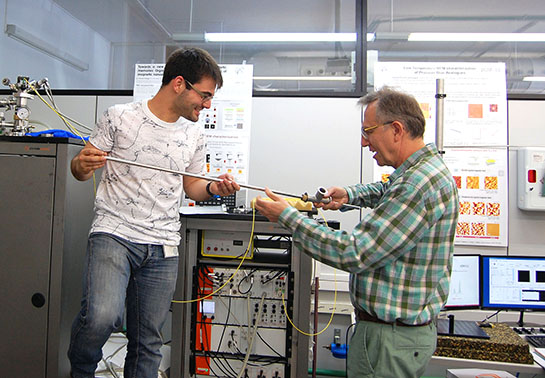Scientists in the Universitat de València develop molecular materials analogous to graphene able to incorporate magnetism
- Fundació Parc Científic
- September 18th, 2018

An international team of chemists and physics, headed by Eugenio Coronado and Guillermo Mínguez Espallargas, researchers at the Institute for Molecular Science of the Universitat de València (ICMoI), located in the Science Park, has been able to produce materials similar to graphene from a molecular approximation. These materials are MUV-1, robust, with a chemical versatility, and are able to incorporate some physical properties such as magnetism.
The results have been published in the Nature Chemistry journal. In this work, 2D metal-organic materials –the MUV-1 (Materials Universitat de València, University of Valencia in Catalan)– are designed from a molecular approximation. Unlike what graphene and other 2D materials do, this new approximation allows tuning the surface properties, turning it from hydrophobic into hydrophilic, and the incorporation of physical properties, such as magnetism, which are difficult to introduce.
The study opens the way to the integration and the application of these materials in different technological fields such as nanoelectronics and spintronics, or in the development of high-sensitive molecular sensors able to selectively recognise and detect particular molecules.
Since the graphene was discovered –the first 2D material made up of a layer of carbon atoms–, many inorganic 2D materials have been prepared. A problem that these materials include is that they do not allow tuning their properties through anchoring molecules on their surface, which prevents the incorporation of new properties or the improvement of their procedure. Besides that, the study of magnetism in 2D materials of inorganic nature known nowadays is a scientific challenge, since all of these materials are chemically unstable at ambient conditions.
The new molecular approximations to 2D materials proposed by the ICMol team to the scientific international community provides solutions to both problems. The possibility to functionalise the surface of these 2D materials at will allows the modulation of their properties in an easy way. Linked to the fact that MUV-1 are mechanically and chemically stable, the procedure has let researches build membranes taking those materials and isolate magnetic monolayers based on coordination chemistry.
The international team that has developed this research is made up of scientists coming from seven European universities –Institute for Molecular Science at the Univesitat de València, the Instituto de Tecnología Química in the Univesitat Politècnica de València, the Spanish National Research Council, the University of Manchester (United Kingdom), Institut Laue Langevin in Grenoble (France), the University of Lisboa (Portugal), and the Delft University of Technology (the Netherlands).
The Universitat de València team, head of the project, is formed by Javier López Cabrelles, Samuel Mañas Valero, Guillermo Mínguez Espallargas and Eugenio Coronado.
The published results in Nature Chemistry have highlighted in the Chemistry World journal (http://ir.uv.es/kinel5s) and in an article from the journal’s blog named Behind the paper (http://ir.uv.es/oqa9rff), among other articles and comments in some reference scientific publications.
Article's reference:
Isoreticular two-dimensional magnetic coordination polymers prepared through pre-synthetic ligand functionalization
Javier López-Cabrelles, Samuel Mañas-Valero, Íñigo J. Vitórica-Yrezábal, Pablo J. Bereciartua, J. Alberto Rodríguez-Velamazán, Joao C. Waerenborgh, Bruno J. C. Vieira, Dejan Davidovikj, Peter G. Steeneken, Herre S. J. van der Zant, Eugenio Coronado, Guillermo Mínguez Espallargas.
Nature Chemistry, DOI: 10.1038/s41557-018-0113-9

Picture: from upper left to bottom right, Guillermo Mínguez, Javier López Cabrelles, Samuel Mañas and Eugenio Coronado.
More information:
File in: Física , Ciencias Tecnológicas , Química
















